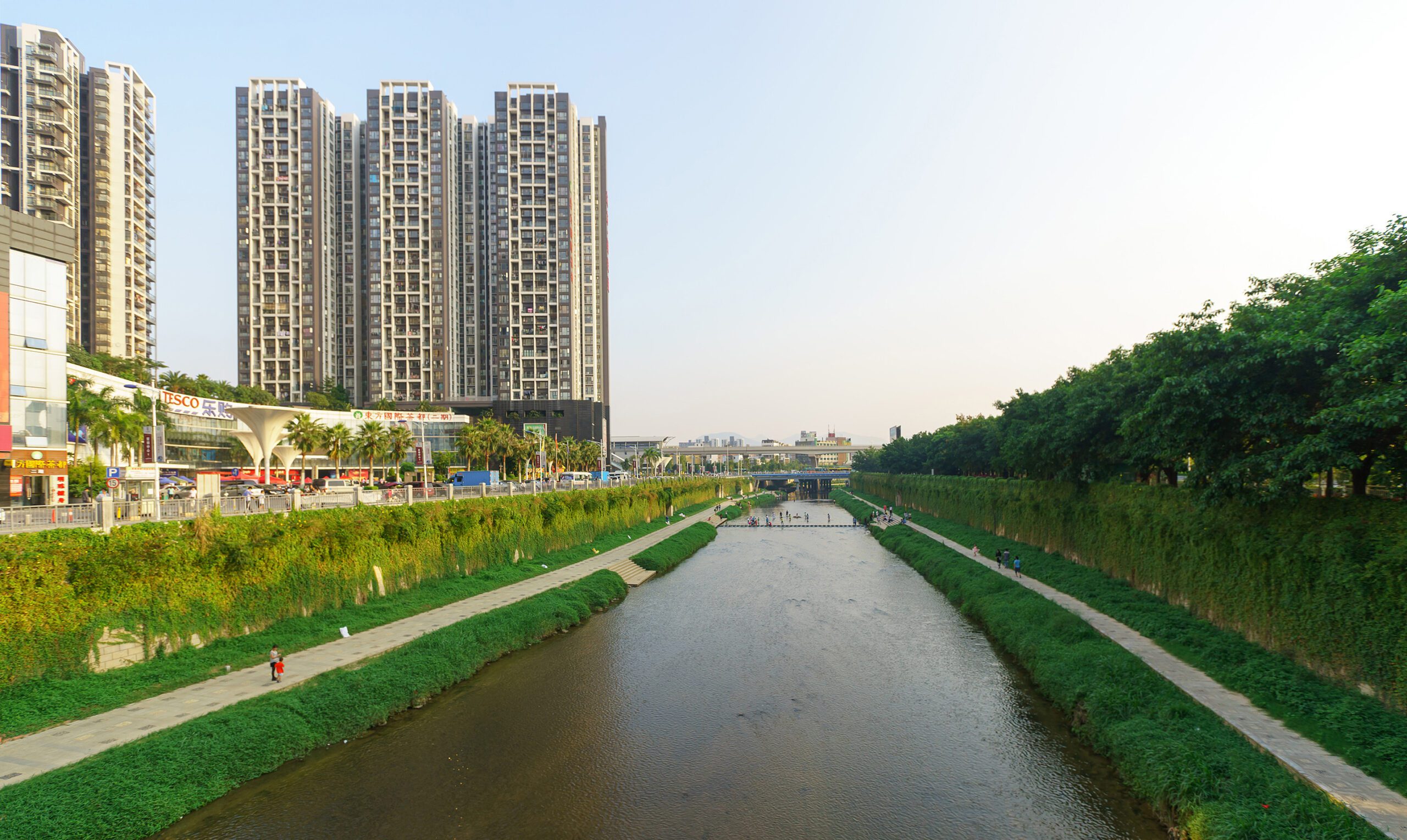-
Decoding China’s Response to Environmental Justice Movement in Shenzhen
The Wutongshan River flows through the east suburbs of Shenzhen and the basin is an important ecological zone for Shenzhen, which is often referred to as the “lungs of Shenzhen.” Rich in plant and animal resources, this area is the city’s natural museum and a genetic reservoir for flora and fauna. The river importantly provides 70% of Hong Kong’s and 40% of Shenzhen’s water.
Following President Xi Jinping’s directives on river management during his inspection of Guangdong in October 2018, the Guangdong Provincial Government launched the Blueway Project in April 2020. The Shenzhen municipal government invested in the project to create a corridor of housing and businesses along the river with the goal of revitalizing the local economy during the pandemic. Municipal officials categorized the project not involving environmentally sensitive areas thereby exempting it from the Environmental Impact Assessment (EIA) process. This prevented the public from gaining information and participating in the planning phase.
By late 2020, residents learned of this large-scale, two-year construction project affecting the entire watershed. The free-flowing river was redirected through large PVC pipes, and the riverbed was excavated and filled with concrete. Trees were removed and construction noise and dust polluted the once-quiet neighborhoods, disrupting local life and businesses. The EIA exemption prompted a spontaneous Not-in-My-Backyard (NIMBY) campaign. Its failure revealed the weakness of environmental activism in the face of local government use of information-blocking and public opinion control. Citizen and NGO environmental activism in China faces hard red lines when it comes to group protests against major infrastructure projects, however justified. But there is still space for citizens and NGOs to participate in improving environmental protection.
Residents Fight Back
In March 2021, concerned residents who lived in the Wutongshan River basin applied for the disclosure of the EIA report, ecological protection measures, ecological restoration plan, and river water quality monitoring data for the project. The government responded within legally required periods, revealing that the construction had no EIA. The construction unit only formulated a rudimentary environmental protection plan that lacked any ecological protection or restoration measures. The project’s feasibility study had simplistic descriptions of its impact on wildlife, stating that “the animals will escape on their own.”
Such disregard for a solid EIA is surprising in Shenzhen, which is considered a leader in urban environmental protection, green transport, and green infrastructure to manage flooding. Moreover, the city has long championed its flexible governance model in handling public concerns with timely responses and direct communication to prevent local environmental issues from turning into mass public protests. In this case, government staff adhered to Open Government Information Regulation in responding to resident requests for information and welcomed continued public monitoring. Yet, the project continued, destroying the local aquatic ecosystem and violating citizen’s environmental rights.
Government Responds with Crackdown
After exhausting internal complaint channels, concerned residents sought external support from environmental nongovernmental organizations (ENGOs). A working group consisting of staff from several grassroots organizations was formed, which then collaborated with environmental law experts and journalists. The group produced a report highlighting three key shortcomings in the project
- Illegal construction in protected areas;
- Unlawful exemption of an EIA; and,
- Negative impact on wildlife.
The report recommended suspending the project until a full EIA was completed and an ecological restoration plan and environmental protection measures were completed. They also advocated for significantly stronger water quality monitoring. In response, the government provided a water quality report, showing no pollution from the project, but excluded turbidity, the most impacted indicator. The authorities agreed to minor site improvements, but maintained that the project qualified for EIA exemption and needed no ecological restoration plans.
The citizen and NGO working group also sought media coverage, but the investigative report was ignored due to excessive negative content, a standard practice of media censorship in China. The group shifted to social media, sharing the investigative report on several ENGO platforms, with one post garnering 186,000 views within 17 hours. This wave of attention, however, sparked no response from the government. Instead, the working group organizers faced investigations from local security departments, who pressed them for information about the campaign and the role of foreign organizations, despite the fact the campaign was a completely spontaneous activity with no involvement or financing from overseas. The security department’s involvement signaled the government had shifted its view of the campaign as an ecological issue to a matter of “stability and national security. The suppression forced the ENGOs to dissolve their WeChat group, marking the end of organized efforts against the project.
Navigating Environmental Advocacy in China
After losing ENGO and media support, Wutongshan community members appealed to the Shenzhen People’s Congress, the city’s legislative body responsible for enacting and overseeing local laws, regulations, and policies. In February 2022, the citizens submitted the investigative report through their state-appointed representative, recommending removing Blueway-related projects from the EIA exemption list and controlling construction intensity within ecological redline zones.
In June 2022, the Shenzhen Ecology and Environment Bureau (EEB) responded, explaining that the EIA exemptions were under central and provincial government directives and could not be changed, but agreed to include environmental impact chapters in future Blueway project plans. The EEB claimed that on-site monitoring found no noise or water pollution, noting the project’s intensity was not excessive. By January 2023, the Wutongshan Blueway was completed and opened to the public, but the watershed’s original biodiversity will never recover.
The repression of the Blueway campaign is a common state response to NIMBY complaints, which explains why most Chinese ENGOs avoid such confrontational campaigns to ensure their organization’s survival and access to state funding. Though advocacy through official state channels remains semi-effective, NGO advocacy and media campaigns are losing impact due to the state’s control over information, highlighting changing realities in environmental activism and public participation within China.
Although the environmental movement has come under pressure from various quarters, there is still space for some forms of public participation, which is one of the most effective ways to address environmental injustices. This requires the public to not only be aware and capable of defending their environmental rights within the legal framework, but it also requires NGOs to provide the necessary technology and resources to support public participation.
Four years have passed since the Blueway campaign started and there still is some space for former working group members to continue to raise public participation around water in other ways. Some are helping local governments monitor river pollution as citizen river chiefs while others are working to improve the standardization of EIAs. Another targeted area of work is organizing children’s nature experience activities. Many are engaged in biodiversity protection and leading citizen science activities assessing the health of local wildlife and plants. There are some NGO members who are bringing clean energy and solar power to remote farming and herding areas in western China to brighten their lives. Despite the failure of the Blueway campaign, all the members have taken new paths to pursue a better environment in their communities and beyond.
This blog is part of the Wilson Center-East-West Center Vulnerable Deltas project that is diving into climate, plastic waste and development threats to three SE Asian and two Chinese deltas. The project is supported by the Luce Foundation.
Zhong Zhao is the founder and director of Green Camel Bell, a grassroots environmental NGO in Northwest China. He’s currently a visiting scholar at the Department of Sociology, Colorado State University. His recent advocacy projects have centered on governance issues concerning environmental justice, public involvement in environmental legislation and decision-making, and the adaptation of international environmental law to local contexts.
KuoRay Mao is Associate Professor of Sociology at Colorado State University-Fort Collins. His research delves into how rural development, environmental crises, and environmental regulatory framework such as how green/nature-based finance may perpetuate environmental injustices in the Global South
Header Photo Credit: SHENZHEN, CHINA – OCTOBER 03, 2013: Longgang district in ShenZhen. ShenZhen is regarded as one of the most successful Special Economic Zones. Photo courtesy of Sorbis / shutterstock.com
Sources: Gov.cn, New Security Beat, Sunday Observer, The Diplomat, Water Authority of Shenzhen Municipality
 A Publication of the Stimson Center.
A Publication of the Stimson Center.









